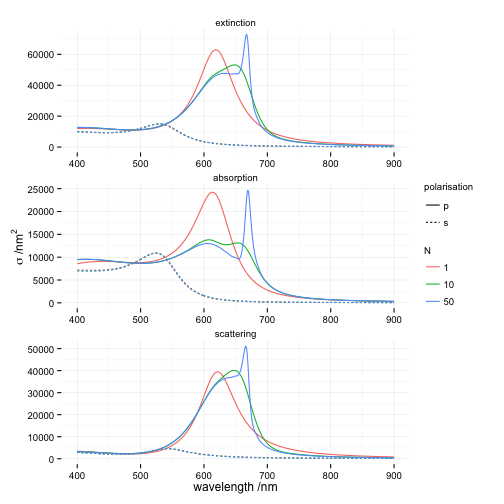-
Notifications
You must be signed in to change notification settings - Fork 4
diffractive_chain
baptiste edited this page Jun 22, 2014
·
5 revisions
baptiste Auguié -- 22 June, 2014
In this example we consider a periodic arrangement of ellipsoids along a line, with a separation of the order of the wavelength. The incident light is perpendicular to the chain axis. As the number of particle grows, the signature of diffractive coupling rises from the shadows of the single-particle spectrum.
# dielectric function
wvl <- seq(400, 900)
gold <- epsAu(wvl)
cl <- cluster_chain(N=10, pitch=500)
rgl.ellipsoids(cl$r, cl$sizes, cl$angles, col="gold")
# visualise
rgl.ellipsoids(cl$r, cl$sizes, cl$angles, col="gold")
chain <- function(N, pitch = 500, ...){
cl <- cluster_chain(N, pitch, ...)
dispersion_spectrum(cluster = cl, material = gold)
}
params <- data.frame(N=c(1, 10, 50))
comparison <- mdply(params, chain)
p <-
ggplot(data=comparison)+ facet_wrap(~type, ncol=1, scales="free")+
labs(y=expression(sigma*" /"*nm^2),
x=expression(wavelength*" /"*nm),
colour = expression(N), linetype=expression(polarisation))+
geom_line(aes(wavelength, value/N, linetype=polarisation,
colour=factor(N),
group=interaction(N,polarisation)))
p